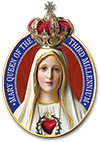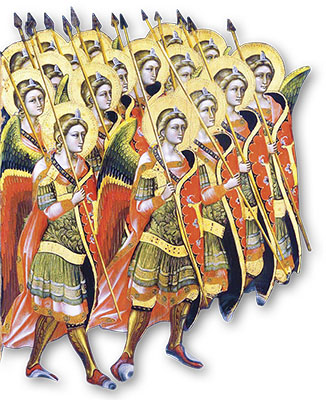
Perhaps Angels are not as we imagine them to be. Several centuries of sentimental religious iconography have ended up peddling us a kind of standardized figure of the winged personage: a youth – or child, according to the taste of the patron – dressed in light robes, or none at all, and nonchalantly exercising his skills on the violin for all eternity. Now, admitting this, we would have to conclude that Paradise is either an immense orchestra of virtuosi or a picturesque nursery for eternal babies…
The truth, it seems, is much more ample. We must not forget that these gentle, diaphanous and pure creatures were born in a fiery Heaven, that they waged war against demons in the very first moments of their existence, and that they were placed at the entrance of Eden to guard it with flaming swords; they are capable of decimating armies and punishing entire cities (cf. Rv 12:7; Gn 3:24; 2 Kgs 19:35; 2 Sm 24:15-17).
When we study them carefully, we find that the Angels are so powerful, combative and, dare we say it, manly – since manliness is above all a spiritual quality – that perhaps they are most adequately described in their entirety with the incomparable formula “heavenly host” (Lk 2:13).
Now, every army has a hierarchy, crowned by a general staff. In the case of the Angels, this is composed of seven elite officers. It is these whom we will now discuss.
How do we know that they exist?

Arpo – Civic Museums of Padua (Italy)
St. Raphael is the one who makes the existence of the seven Archangels known to us. After having accomplished his mission with the family of Tobit, he reveals his true nature and affirms that he belongs to this select group of spirits (cf. Tb 12:15). Although he does not even use the term Archangel, which is used only twice in the Scriptures, both times in the New Testament, his words form the basis of our faith in the existence of the seven Archangels.
Tobit’s helper presents himself as one of the angelic beings who serve before God and enter into the presence of His glory. This function, described by Raphael with such simplicity, is enough to elicit the holy envy of any creature. It is an office analogous to that of the direct servants of an earthly king; these seven Angels have free access to the intimacy of the Most High, in the quality of confidants and ministers. They belong, therefore, to the choir of Seraphim, whose function is to be in close relationship with God and to love Him, not with ordinary dilection, but with a “burning love”.
What are their names?
It must be said that the Angels have always shown a curious reluctance to reveal their own names. Manoah, Samson’s father, tried to find out one of them when the spirit appeared to him, but to no avail… The reply came almost as a rebuke: “Why do you ask my name, seeing it is wonderful?” (Jgs 13:18).
In reality, angelic creatures need not bother with this kind of formality, since they do not communicate through words. The designations under which they present themselves simply refer to the mission they carry out among men. These are adapted to the human intellect, that is, they are always far less than reality… Perhaps for this reason only three of the seven Archangels have officially revealed their names, that is, in a manner accepted by the Holy Church as being part of public Revelation: St. Michael, St. Gabriel and St. Raphael.
In the first centuries of the Church there was the custom of venerating other angelic spirits by name, especially on the basis of information taken from the apocryphal books. This ended in the year 745, when Pope St. Zachary, at the request of St. Boniface, condemned a certain Adelbert, who is supposed to have used some of these invocations for witchcraft. In the synod that impugned the heretic, it was reiterated that the Church officially recognizes only the three aforementioned appellations.
The Pope did not declare it illicit to give names to Angels; he only condemned those used by the sorcerer. Proof of this is that Saints subsequent to the pontificate of Zachary adopted this practice. Clearly, however, it is still advisable to proceed with caution in this matter.
In any case, four of the seven Archangels are still unknown to mankind, and they will remain so until they themselves deign to throw some light upon the subject. We see no other way than through a private revelation approved by the Church. But that does not depend on us…
Their missions
Above, we raised the consideration that the seven Archangels are Seraphim. However, they do not spend all their time exclusively contemplating God. When they set out to fulfil some “practical” mission that the Most High has entrusted to them, their burning love is transformed into zeal, and their action is precise, effective and powerful.
While he was in exile in Babylon, the prophet Ezekiel found himself mystically carried to the inner court of the Temple in Jerusalem. It was revealed to him that, in the sacred precincts themselves, idolatry was being practised – probably the worship of the goddess Astarte, the Phoenician version of Venus, whose cult was usually associated with obscene actions. To add to the scandal, “portrayed upon the wall round about, were all kinds of creeping things, and loathsome beasts” (Ez 8:10) being incensed in certain chambers around the Temple, which appear to have been the priests’ quarters. At the heart of the true Religion, the men called to be the spearhead of fervour turned the House of God into a den of abominations. That sin could not go unpunished.
Soon six men appeared, each carrying his “weapon for slaughter” (Ez 9:2) in his hand. They were led by a seventh personage, dressed in linen like the priests and carrying a writer’s case hanging from his waist. Those Angels in human form were given precise instructions: first of all, the last of them was to go around Jerusalem marking with a cross the forehead of those who groaned and sighed because of the sins committed in the city; then the other six were to exterminate all the wicked who did not have this sacred sign, starting from the Sanctuary. The terms of the order are striking for their truculence: “Defile the house, and fill the courts with the slain. Go forth” (Ez 9:7).
Once the operation was over, in a typically military manner, the commander of the detachment went to render an account to the authorities, with a disconcerting objectivity and sang-froid – if such can be said of one who has no blood: “I have done as thou didst command me” (Ez 9:11). And Jerusalem was in fact soon devastated by Nebuchadnezzar.
The Angels with trumpets
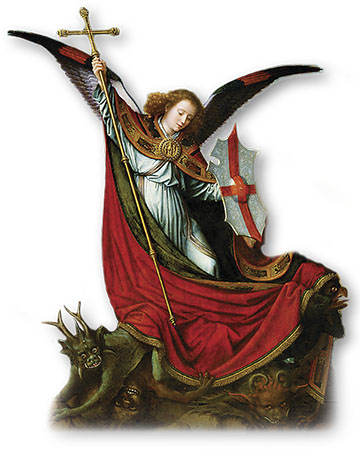
St. Michael, by Gerard David – Kunsthistorisches Museum, Vienna
We see the seven Archangels once again in the eighth chapter of Revelation, this time not with mysterious weapons, but with trumpets. When these are blown, they unleash terrible plagues upon the earth and – a curious detail – the divine punishment is meted out in response to the prayers of the Saints (cf. Rv 8:3-5).
It is reassuring to note that their methods are very similar to those in Ezekiel’s vision: the punishment refrains from striking those marked on their foreheads with the seal of God (cf. Rv 9:4).
In fact, they do not merely spare the righteous. The same force of irresistible impact and victorious tenacity used against evil to mercilessly exterminate it, is employed by the seven Archangels to protect, guide and encourage the good. While it is said that Guardian Angels are appointed to watch over individual men, the seven Archangels seem to guard a mystical reality: the Churches of the Book of Revelation.
Seven spiritual families in the Mystical Body of Christ
The mysterious text with which Revelation closes is simply fascinating. Every word, every detail, every gesture we come upon are like precious stones in an enormous kaleidoscope: while remaining the same, they seem to rearrange and rearticulate themselves, forming new pictures of marvellous depths.
At the very beginning of the work, St. John tells how he was taken by the spirit and heard a strong voice saying to him: “Write what you see in a book and send it to the seven churches” (1:11). The very tone of the utterance already seems to suggest that it contains a sublime unknown. And the mystery becomes even more fascinating when we learn the poetic names of the communities: Ephesus, Smyrna, Pergamum, Thyatira, Sardis, Philadelphia and Laodicea. Who are these groups?
First of all, the names indicate real cities, which were found in the proconsular province of Asia, part of present-day Turkey. It is legitimate to admit that the Apostle was addressing the Christian communities in each of these places. But what would lead him to choose only these, when in the same region there were others, and of greater importance? To think that the Holy Spirit arranged the sacred text in this way for merely “logistical reasons” of dispatching the messages, as some would have it, is surely to underestimate the power of His divine wings.
Certain authors opted for a more transcendent vision. St. Bonaventure and the Venerable Bartholomew Holzhauser, for example, interpreted the Churches as seven phases in the history of the Universal Church, from its foundation until the end of time.
Another particularly interesting exegesis is that of Dr. Plinio Corrêa de Oliveira, who hypothesized that these Churches were spiritual tribes or families within the Mystical Body of Christ: paradigmatic types of Catholic mentalities, endowed with different attributes in the struggle, with their good and bad sides.
These three modes of understanding the scenario, although diverse, are not contradictory. On the contrary, they could even be said to complement each other. It is a fascinating topic, full of ramifications that would be beyond the scope of this article, but – who knows? – may be the subject of another article. For the moment, it is enough to remember Dr. Plinio’s vision, because it will allow us to advance in our puzzle. Let us look, now, for the missing pieces.
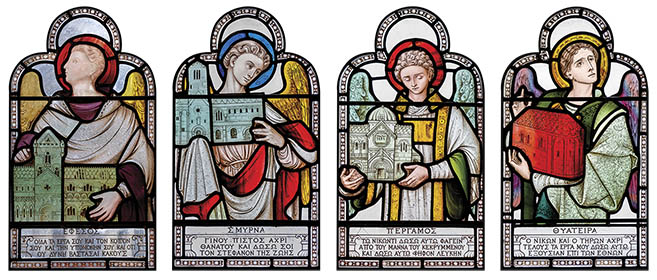
From left to right: The Angels of the Churches of Ephesus, Smyrna, Pergamum and Thyatira – Cardiff Castle (Wales)
The Angels of the Churches
Another point to consider is the immediate recipient of the letters. St. John does not write directly to the whole community, but to a type of leader. In each of the missives, the opening words are invariably, “To the Angel of the Church of…” Who are these personages?
The matter is not as simple as we might think at first sight. To begin with, although it seems obvious that the Apostle is addressing Angels – after all, it reads that way – the true identity of the representatives of the Churches has been disputed since ancient times. Many authors prefer to see in them only the Bishops of each community, or even simple fictitious entities, employed as a rhetorical device. Until today no hypothesis has been presented as definitive, and for every argument in favour, there must be at least two or three against.12 This is what led St. Augustine to call the question “res obscurissima”.
In the absence of unanimity, we feel entitled to choose the opinion of Origen, who interprets them as actual Angels. Let us unite this with Dr. Plinio’s hypothesis: would it not be heartening to think that each one of the seven spiritual families of the Holy Church is under the protection of a powerful angelic being? Thus, the family we belong to would determine a patron to watch over us with special affection, ready to help us in any situation, provided we have recourse to him.
Now the problem arises: which Angels are they?
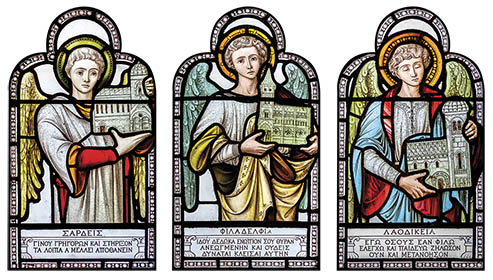
An encouraging hypothesis
Apocalypse does not state categorically that they are our already-familiar seven Archangels; St. John only refers to them explicitly later on, in the eighth chapter. However, it is remarkable that, in presenting them, he expresses himself as if they were known. Was there, then, a prior reference, even if implicit? Turning to St. Bonaventure, perhaps we find the answer, together with the last missing piece to complete the mosaic.
Seven septenary series make up the Apocalypse: there are seven letters, seven seals, seven trumpets, seven bowls of God’s wrath, etc. (cf. Rv 2-3; 6-8, 1; 8, 2-11; 16). According to the Seraphic Doctor, these cycles repeat the same content in different ways, in perfect harmony.
It is possible then to conjecture that the Angels contemplated in the eighth chapter are identical to those in all the other series, albeit presented from another perspective. Thus the sublime guardians who watch over the Churches may perfectly well be the seven Archangels.
More than guardians: allies!
And why not? Scripture compares these most perfect spirits to the “eyes of the Lord,” which scan the whole earth like a company of sentinels; in the Hebrew text it calls them the Angels of the Lord’s face, ready to save the people of the Covenant in all their troubles (cf. Zec 4:10; Is 63:9).
They are much more than mere guards: they are our companions in the fight. Providence has granted us to close ranks in a single military corps with His principal combatants. In our war against the power of darkness, which includes both great ventures and small day-to-day skirmishes, we can be sure that their help is within our hands’ reach: it is enough to join them together and pray.
